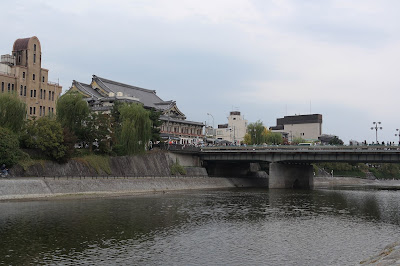Kyoto and Nara are two former Imperial Japanese capitals, that have become field trip destinations for Japanese students. Since these cities were only about an hour away from Osaka, both were on my itinerary for sightseeing.
Kyoto
Both the Hankyu line and Kintetsu line can be used to get from Osaka to Kyoto. I used the Hankyu line on my first trip to Kyoto, but on subsequent trips, I took the Kintetsu line, since I bought a Kintetsu Rail Pass.
The Kintetsu Rail Pass was well worth it. I purchased a 5-day pass which allows travel to the most destinations. The pass came with three vouchers that allow you to take limited express trains for no extra cost.
The vouchers say that you should make a reservation at the station office in advance, but the conductor can fill out the voucher on the train itself if necessary (though you may be asked to move to another seat).
The Kintetsu Rail Pass can be purchased at specifically designated Bic Camera stores in Japan, but they only accept cash for payment, and they need to see your passport to verify that you are a tourist.
The train stops at Kyoto Station from where you can see Kyoto Tower just to the north.
 |
| Kyoto Tower |
In Kyoto, I traveled primarily by bus. I recommend buying a day pass at Kyoto Station to get around town. Get onto the bus from the rear entrance, and pay when you exit from the front. Stops are announced in Japanese, English, Mandarin Chinese, and Korean for the convenience of tourists.
Advertisements in the bus promoting the use of the subway featured the Kyoto MTB subway mascot girls.
I would definitely watch an anime of their adventures riding the subways of Kyoto if one was made.
Not far to the east of the station is the Kamo River.
Ponto-cho is a historical district along the embankment of the river consisting of many restaurants.
After a picnic by the Kamo, I stopped by Nijō Castle, built in 1603 as a residence for Tokugawa Ieyasu, and currently a UNESCO World Heritage Site.
Circling back toward Kyoto Station, I went to Nishi Honganji. The original temple was built in 1591 by Toyotomi Hideyoshi to replace the Ishiyama Honganji in Osaka destroyed by Oda Nobunaga.
As dusk fell, I returned to Osaka. I would return a couple of days later to visit Fushimi Inari Shrine, the head shrine dedicated to Inari.
The shrine is a bit out of the way, and the best way to get there is to take the JR Nara line from Kyoto Station to the JR Inari Station.
I wanted to take in my surroundings, so I decided to walk part of the way instead.
 |
| 猫 だ。 |
I initially arrived at the temple at one of the smaller entrances at the side of the complex, and ended up leaving through the front.
 |
| Inari, Konkon, Koi Iroha |
The next stop was Kiyomizu-dera, a Heian period temple listed as a UNESCO World Heritage Site.
 |
| 清水の舞台から飛び降りる |
 |
| Koyasu Pagoda |
 |
| Otowa no Taki |
On the way back to the station, I stopped by Demachi Masugata Shoutengai – the inspiration for Usagiyama Shoutengai from the anime Tamako Market. If you visit, be sure to go early, since many of the stores close around sunset.
The next day I returned to Kyoto and visited some obligatory school trip tour sites. Kinkaku-ji was commissioned by the Muromachi shogūn Ashikaga Yoshimitsu, and is listed as a UNESCO World Heritage Site.
The current pavilion is a reconstruction of the original building, which burned down in 1950.
 |
| I made it in the pot on my first and only toss using a heavy one yuan coin. It made a loud ring that drew the cheers of some nearby students and their teacher chaperones. |
Kitano Tenman-gū is the head shrine dedicated to Sugawara Michizane (aka Tenjin).
Tenman-gū shrines are popular with students praying for success in exams and this one is no different, though requests to Tenjin are conveyed through the intermediary of the many cow statues on the grounds of the shrine.
Ginkaku-ji was commissioned by the Muromachi shogūn Ashikaga Yoshimasa. It was patterned after the Kinkaku-ji commissioned by his grandfather, and there were plans to cover the entire structure in silver foil, but the project was never completed.
 |
| ニルバナ |
The next time I visit Kyoto, I think that I will book a ryokan.
Nara
I got to Nara from Osaka using the Kintetsu Line. The first stop after lunch was Kōfuku-ji, a temple complex listed as a UNESCO World Heritage Site. It was originally established in Kyoto, but then moved to Nara. It is considered to be the tutelary temple for the Fujiwara clan.
From the temple, I walked over to the Nara National Museum. The visit was brief since the museum was undergoing renovation, and there was only a temporary exhibit with only a few items on display.
Nearby is Nara Park, the center of the city's main tourist destinations. There are supposed to be ~1200 deer that roam freely in and around the vicinity, but despite what you may hear about the deer being tame, they are still wild animals.
 |
| There are signs like this near my house too! |
Tōdai-ji is another temple complex that is listed as a UNESCO World Heritage Site.
 |
| Nandaimon |
Within the complex is the Daibutsuden, housing the world's largest bronze statue of the Vairocana Buddha.
 |
| Vairocana Daibutsu |
 |
| Kokuzo-Bosatsu |
 |
| Nyoirin Kannon |
 |
| Buddha's hand |




















































No comments:
Post a Comment